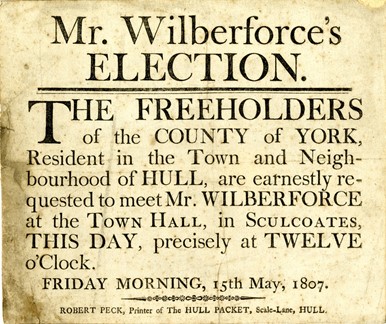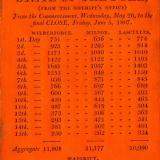The Great Yorkshire Election Of 1807
Having lived through the recent tumultuous election of Joe Biden as President of the United States I thought members may like to read about the famous Yorkshire election which took place in May-June 1807. In the eighteenth century there were three parliamentary boroughs in the East Riding - Kingston upon Hull, Beverley and Hedon - each returning two Members of Parliament. If you were not a freeman of any of these towns, then for East Riding freeholders your constituency was the vast county of Yorkshire, which also returned two MPs. The growing industrial towns in the West Riding, Leeds, Sheffield and Bradford were not parliamentary boroughs, and their residents were also part of the county-wide constituency. To vote in a Yorkshire election you had to be a male ‘forty-shilling freeholder’ – that is one who owned land with a rental value of forty shillings a year or more. Even if you had the right to vote there was little chance of you exercising that privilege in a Yorkshire election in the eighteenth century. It was such a costly business for the candidates that, as in America, few were prepared to stand for election who were not immensely wealthy or without wealthy backers. There was a byelection in 1742, for one of the Yorkshire seats, but no further election in the county until 1807. On the numerous other occasions when elections were called nationally between these dates, the leading Yorkshire gentry and aristocracy agreed on the two candidates to be returned without the need for a ballot. For an election to occur there had to be three candidates, as there were two seats per constituency. Each voter had two votes, and could choose to vote for two candidates, or just one – in the latter case his vote was called ‘a plumper’ and was particularly sought by candidates.
There were three candidates in 1807: William Wilberforce, who had been one of the MPs for Yorkshire since 1784, standing as an Independent Tory, and two members of wealthy aristocratic Yorkshire families, Henry Lascelles, a Tory, and Lord Milton, a Whig. Wilberforce had a great following through his attention to county business, his appealing personality, and his untiring, and recently successful, campaign against the slave trade. Lascelles from Harewood, on the other hand, came from a family whose fortune and position was largely founded on slave plantations in Barbados. Milton, only just 21, was the son of Lord Fitzwilliam, and he had strong support from West Riding clothiers.
Voting had to be done in person, and at booths erected in the Castle Yard in York. Voting took place over fifteen days with 22,263 voters converging on the city from all over the county and further afield. It was where you owned land rather than place of residence that was important. If you lived in London but owned land in Yorkshire you had two votes to cast at York. The candidates had London committees recruiting Yorkshire voters and funding their travel and other expense. The committee set up by Wilberforce supporters in Beverley sought subscriptions, canvassed support and appointed agents at the Tiger Inn and Beverley Arms Inn from where they arranged carriages to take voters to York. Voters were given a guinea ‘expenses’. This committee spent £1,035 on the election
The Yorkshire Herald reported on 6 June 1807:
‘Nothing since the days of the revolution has ever presented to the world such a scene as has been for fifteen days and nights passing within this great county. Repose or rest have been unknown in it, except it was seen in a messenger, totally worn out, asleep upon his post-horse, or on his carriage. Every day the roads in every direction, to and from every remote corner of the county have been covered with vehicles loaded with voters; and barouches, curricles, gigs, flying wagons, military cars with eight horses to them, crowded sometimes with forty voters, have been scouring the country, leaving not the smallest chance for the quiet traveller to urge his humble journey, or find a chair at an inn to sit down upon.’
It was a close fought contest. Every evening over the 15 days, the ‘state of the poll’ was published giving the number of votes cast for each candidate. Great efforts were made to bring every voter to York, no matter the distance or how aged or infirm. It was on the 4th day that Wilberforce obtained the first place that he retained until the end of the election, but Milton was in third position from the 4th to 13th day. Wilberforce (11,808 votes) and Milton (11,177) were returned as the MPs. Lascelles (10,990) lost by only 187 votes. Most of Wilberforce’s and Lascelles’s votes were shared but Milton had almost 9,000 plumpers. The election cost Lascelles and Milton, around £100,000 each (at least £6 million pounds today), chiefly their own or family money, but Wilberforce’s expenses were less than £30,000, all from voluntary subscriptions.
Until 1870 the way individuals voted was not secret and was often published in printed poll books, as it was for the 1807 election. In the East Riding Wilberforce received 77 per cent of the votes, Lascelles 50 per cent and Milton 37 per cent. There were very few East Riding towns or villages where Wilberforce did not get support from at least half the voters. At Pocklington 89 per cent of the voters used one of their votes for Wilberforce. In contrast all eleven voters from Bishop Burton supported Milton and only three also voted for Wilberforce. In estate villages it was expected that the residents, despite being freeholders, usually elsewhere, would vote the way the landowner decided. At Bishop Burton the slave-owning squire Richard Watt plumped for Milton.
David Neave November 2020

 1807 Poll Results
1807 Poll Results List of electors 1807
List of electors 1807

